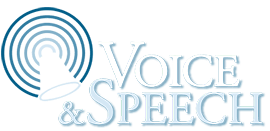Transcript
I have a friend and colleague who is a former broadcaster. He currently works as a voice over artist and coaches other media and recording professionals. One of his pet peeves is audible breathing. One, two three, four, five [gasp], six, seven, eight, nine, ten [gasp], eleven, twelve, thirteen, fourteen, fifteen [gasp, gasp, gasp]
Now that’s understandable if you’re working with a mic in front of your mouth. Those loud gaspy in-breaths are distracting and unpleasant when recorded up close and amplified. Most people don’t need to be that particular about it in their everyday speech, and I don’t spend a lot of time addressing it directly with my students. However…
Audible breaths are an indication of tension in your voice. That gaspy sound is caused by air turbulence. Turbulence is caused by something obstructing the flow of air. So when you hear yourself breathing [gasp] or feel that scraping quality on your in-breath, that’s a sign your airway is closing. That’s a problem because the quality of your in-breath sets up the quality of your voice. So if you’re tense breathing in, there will be tension in the voice coming out.
Audible breaths are often the result of quick, high in-breaths. When you’re grabbing small, quick breaths, you’re probably lifting your chest. That activates the muscles in the front and sides of your neck and those muscles put pressure on the channel so it’s not as open. You need to cultivate the ability to relax on the inhalation and take open effortless in-breaths.
How can you cultivate a relaxed and silent in-breath? The first exercise that comes to my mind is The Straight Pipe. You can watch a 45-second summary of this simple voice exercise by clicking this link [point to annotation and you might want to watch the whole video later.
Now, of course you’re not going to speak with your head tilted back all the time. You’re just doing that for practice, to learn the feeling of breath flowing through a completely open unobstructed channel, with no interference. Once you know that feeling it’s not a big deal to bring your head forward and keep that breath just as open and silent.
I’m not going to have a heart attack every time I hear an audible breath. I’ll be the first to admit you can pick any video on this channel and hear some audible breaths—but—if it’s a pattern, that’s an indication of throat tension, and that is a problem for your voice. Furthermore, if you perform with a microphone it becomes a problem for your sound engineer and for your listeners.
Great speech is all about openness, and that openness starts in your body. Learning to inhale without closing the breath channel will be a significant step toward discovering your optimal voice.
For more exercises to optimize your breathing and open your voice, click the link in the description box, and enroll in the free video mini course, The Sound of Success.
Voice Training: Silent In-Breath
Voice training involves a lot of breathing exercises, and one of the qualities to be cultivated is a breath that’s easy, open, deep and silent. Noisy in-breaths are a sign of throat tension and that obviously limits your voice. Training yourself keep the breathing channel completely open and smooth when you inhale will be a significant improvement in your speaking voice.


